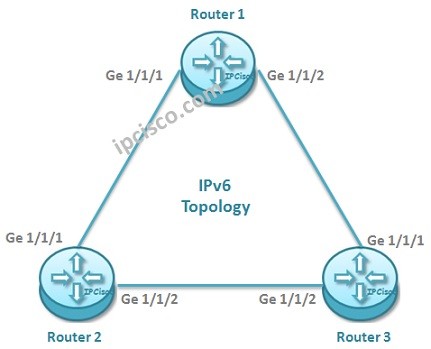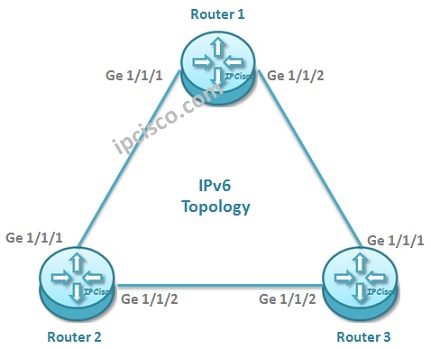- COURSES
- SPECIALS
- BLOG
- MEMBERS
- SHOP
- ABOUT
- ENROLL HERE

In this configuration example, we will configure IPv6 Address on Juniper Routers. For our Juniper IPv6 Address Configuration Example, we will use the below IPv6 Topology consist of three Juniper routers.

In this ipv6 configuration example, we will use the below IPv6 Addresses.
Router 1
Interface Ge 1/1/1 2001:aaaa::1/64 (To Router 2)
Interface Ge 1/1/2 2001:bbbb::1/64 (To Router 3)
Router 2
Interface Ge 1/1/1 2001:aaaa::2/64 (To Router 1)
Interface Ge 1/1/2 2001:cccc::1/64 (To Router 3)
Router 3
Interface Ge 1/1/1 2001:bbbb::2/64 (To Router 1)
Interface Ge 1/1/2 2001:cccc::2/64 (To Router 2)
Let’s configure each Juniper router interfaces with IPv6 addresses given above.
Router 1> edit[edit]Router 1# set interfaces ge-1/1/1 unit 0 family inet6 address 2001:aaaa::2/64[edit]Router 1# set interfaces ge-1/1/2 unit 0 family inet6 address 2001:bbbb::1/64[edit]Router 1# commit check[edit]Router 1# commit
Router 2> edit[edit]Router 2# set interfaces ge-1/1/1 unit 0 family inet6 address 2001:aaaa::2/64[edit]Router 2# set interfaces ge-1/1/2 unit 0 family inet6 address 2001:cccc::1/64[edit]Router 2# commit check[edit]Router 2# commit
Router 3 IP Address Configuration
Router 3> edit[edit]Router 3# set interfaces ge-1/1/1 unit 0 family inet6 address 2001:bbbb::2/64[edit]Router 3# set interfaces ge-1/1/2 unit 0 family inet6 address 2001:cccc::2/64[edit]Router 3# commit check[edit]Router 3# commit
After this Juniper ipv6 address configuration, we can check our interfaces with “show interfaces terse” and “show ipv6 neighbours” commands.
Router 1# show interfaces terse
Router 1# show ipv6 neighbours
Router 2# show interfaces terse
Router 2# show ipv6 neighbours
Router 3# show interfaces terse
Router 3# show ipv6 neighbours
Here, we need also a Static Route for all the routers. Or we can use a Routing Protocol. Because, there is one more network for each Router, that they are not directly connected. As you know, routers can reach only directly connected routers without an additional route.
Here, the better solution is writing a static route for each router. We will explain it in the Juniper Static Route configuration lessons.
Leave a Reply